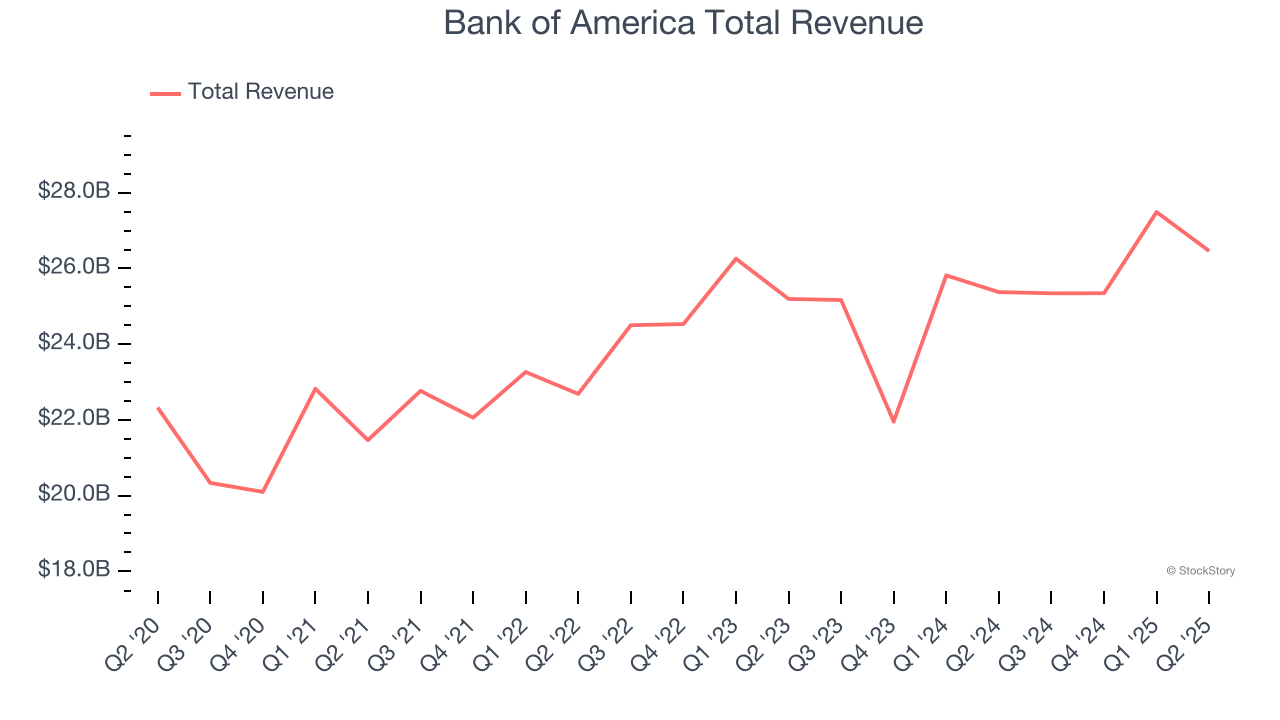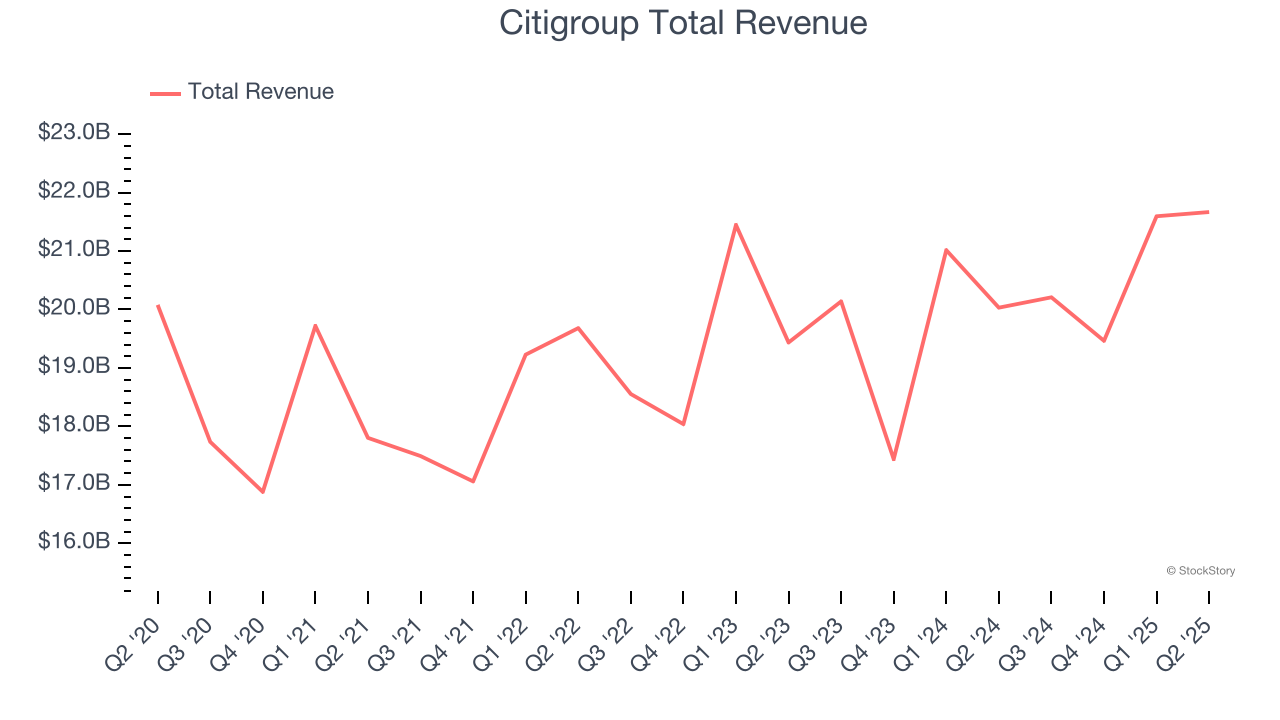
Quarterly earnings results are a good time to check in on a company’s progress, especially compared to its peers in the same sector. Today we are looking at Bank of America (NYSE: BAC) and the best and worst performers in the diversified banks industry.
At their core, diversified banks take in deposits and engage in various forms of lending, which means revenue is generated through interest rate spreads (difference between loan and deposit rates) and fees. Other revenue comes from adjacent services such as wealth management, card and account fees, and products such as annuities. These institutions benefit from rising interest rates that improve NIMs (net interest margins), digital transformation reducing operational costs, and expanding wealth management services as populations age. However, they face headwinds including fintech competition disrupting traditional models (how disruptive is crypto?), stringent regulatory requirements increasing compliance costs, and cybersecurity threats requiring substantial technology investments. Economic downturns also pose risks through potential loan defaults and compressed margins during accommodative monetary policy periods.
The 7 diversified banks stocks we track reported a mixed Q2. As a group, revenues beat analysts’ consensus estimates by 1.1%.
While some diversified banks stocks have fared somewhat better than others, they have collectively declined. On average, share prices are down 1.1% since the latest earnings results.
Bank of America (NYSE: BAC)
Tracing its roots back to 1784 and now serving approximately 67 million consumer and small business clients, Bank of America (NYSE: BAC) is a global financial institution that provides banking, investing, asset management, and risk management products and services to individuals, businesses, and governments.
Bank of America reported revenues of $26.46 billion, up 4.3% year on year. This print was in line with analysts’ expectations, but overall, it was a slower quarter for the company with a slight miss of analysts’ net interest income estimates and EPS in line with analysts’ estimates.

The market was likely pricing in the results, and the stock is flat since reporting. It currently trades at $45.84.
Read our full report on Bank of America here, it’s free.
Best Q2: Citigroup (NYSE: C)
With operations in nearly 160 countries and a history dating back to 1812, Citigroup (NYSE: C) is a global financial services company that provides banking, investment, wealth management, and payment solutions to consumers, corporations, and governments.
Citigroup reported revenues of $21.67 billion, up 8.2% year on year, outperforming analysts’ expectations by 3.5%. The business had an exceptional quarter with a solid beat of analysts’ EPS estimates and a solid beat of analysts’ net interest income estimates.

Citigroup achieved the biggest analyst estimates beat among its peers. The market seems happy with the results as the stock is up 5.3% since reporting. It currently trades at $92.12.
Is now the time to buy Citigroup? Access our full analysis of the earnings results here, it’s free.
Weakest Q2: U.S. Bancorp (NYSE: USB)
With roots dating back to 1863 and a presence across 26 states primarily in the Midwest and West, U.S. Bancorp (NYSE: USB) is one of America's largest banks providing lending, deposit services, wealth management, payment processing, and merchant services to individuals and businesses.
U.S. Bancorp reported revenues of $6.98 billion, up 2% year on year, falling short of analysts’ expectations by 0.7%. It was a slower quarter as it posted a miss of analysts’ net interest income and tangible book value per share estimates.
U.S. Bancorp delivered the weakest performance against analyst estimates in the group. As expected, the stock is down 2.4% since the results and currently trades at $44.58.
Read our full analysis of U.S. Bancorp’s results here.
Truist Financial (NYSE: TFC)
Born from the 2019 merger of BB&T and SunTrust in one of the largest banking combinations since the 2008 financial crisis, Truist Financial (NYSE: TFC) is a bank holding company that offers a wide range of financial services including consumer and commercial banking, wealth management, insurance, and lending solutions.
Truist Financial reported revenues of $4.99 billion, up 396% year on year. This number met analysts’ expectations. Taking a step back, it was a slower quarter as it logged a miss of analysts’ EPS estimates and net interest income in line with analysts’ estimates.
Truist Financial pulled off the fastest revenue growth among its peers. The stock is down 3% since reporting and currently trades at $43.69.
Read our full, actionable report on Truist Financial here, it’s free.
Wells Fargo (NYSE: WFC)
Founded during the California Gold Rush in 1852 to provide banking and express delivery services to miners and merchants, Wells Fargo (NYSE: WFC) is a diversified financial services company that provides banking, lending, investment, and wealth management services to individuals and businesses.
Wells Fargo reported revenues of $20.82 billion, flat year on year. This result beat analysts’ expectations by 0.8%. Aside from that, it was a mixed quarter as it also produced a decent beat of analysts’ EPS estimates but a slight miss of analysts’ net interest income estimates.
The stock is down 6.9% since reporting and currently trades at $77.62.
Read our full, actionable report on Wells Fargo here, it’s free.
Market Update
In response to the Fed’s rate hikes in 2022 and 2023, inflation has been gradually trending down from its post-pandemic peak, trending closer to the Fed’s 2% target. Despite higher borrowing costs, the economy has avoided flashing recessionary signals. This is the much-desired soft landing that many investors hoped for. The recent rate cuts (0.5% in September and 0.25% in November 2024) have bolstered the stock market, making 2024 a strong year for equities. Donald Trump’s presidential win in November sparked additional market gains, sending indices to record highs in the days following his victory. However, debates continue over possible tariffs and corporate tax adjustments, raising questions about economic stability in 2025.
Want to invest in winners with rock-solid fundamentals? Check out our Hidden Gem Stocks and add them to your watchlist. These companies are poised for growth regardless of the political or macroeconomic climate.
StockStory is growing and hiring equity analyst and marketing roles. Are you a 0 to 1 builder passionate about the markets and AI? See the open roles here.



